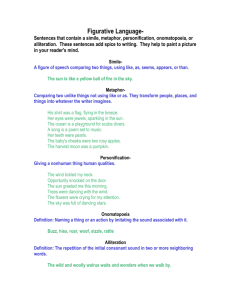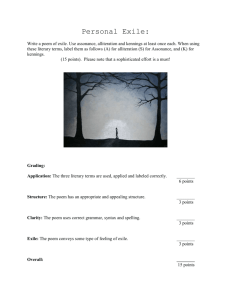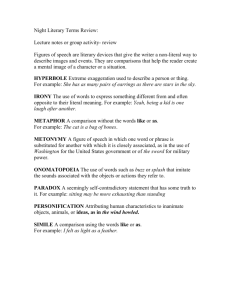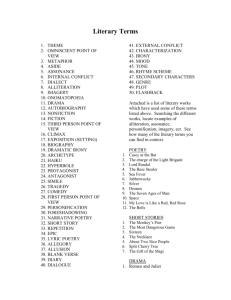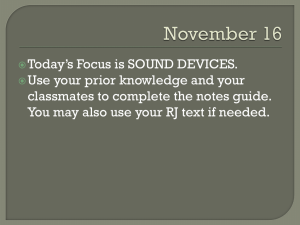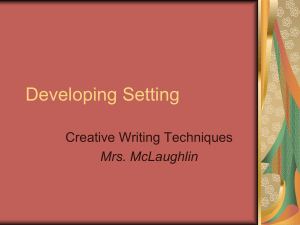2 Second Grade Lesson Planning Guide
advertisement
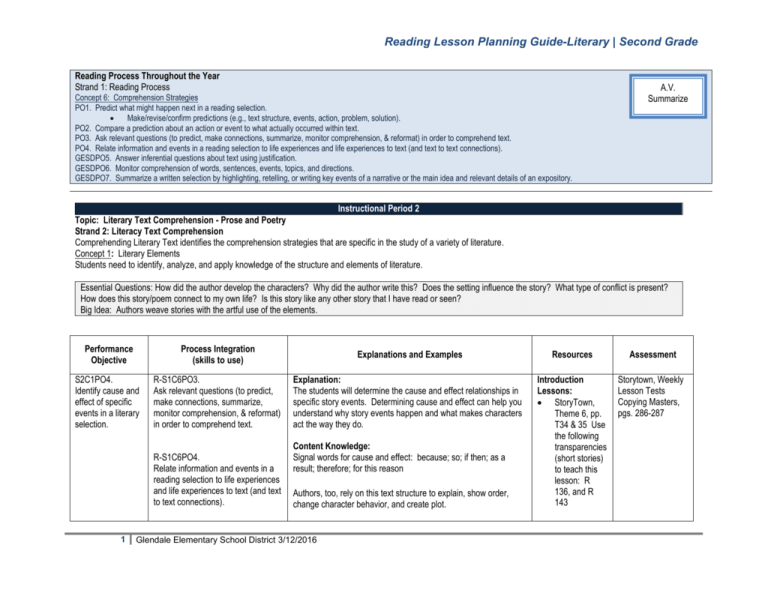
Reading Lesson Planning Guide-Literary | Second Grade Reading Process Throughout the Year Strand 1: Reading Process Concept 6: Comprehension Strategies PO1. Predict what might happen next in a reading selection. Make/revise/confirm predictions (e.g., text structure, events, action, problem, solution). PO2. Compare a prediction about an action or event to what actually occurred within text. PO3. Ask relevant questions (to predict, make connections, summarize, monitor comprehension, & reformat) in order to comprehend text. PO4. Relate information and events in a reading selection to life experiences and life experiences to text (and text to text connections). GESDPO5. Answer inferential questions about text using justification. GESDPO6. Monitor comprehension of words, sentences, events, topics, and directions. GESDPO7. Summarize a written selection by highlighting, retelling, or writing key events of a narrative or the main idea and relevant details of an expository. A.V. Summarize Instructional Period 2 Topic: Literary Text Comprehension - Prose and Poetry Strand 2: Literacy Text Comprehension Comprehending Literary Text identifies the comprehension strategies that are specific in the study of a variety of literature. Concept 1: Literary Elements Students need to identify, analyze, and apply knowledge of the structure and elements of literature. Essential Questions: How did the author develop the characters? Why did the author write this? Does the setting influence the story? What type of conflict is present? How does this story/poem connect to my own life? Is this story like any other story that I have read or seen? Big Idea: Authors weave stories with the artful use of the elements. Performance Objective Process Integration (skills to use) Explanations and Examples Resources Assessment S2C1PO4. Identify cause and effect of specific events in a literary selection. R-S1C6PO3. Ask relevant questions (to predict, make connections, summarize, monitor comprehension, & reformat) in order to comprehend text. Explanation: The students will determine the cause and effect relationships in specific story events. Determining cause and effect can help you understand why story events happen and what makes characters act the way they do. Introduction Lessons: StoryTown, Theme 6, pp. T34 & 35 Use the following transparencies (short stories) to teach this lesson: R 136, and R 143 Storytown, Weekly Lesson Tests Copying Masters, pgs. 286-287 R-S1C6PO4. Relate information and events in a reading selection to life experiences and life experiences to text (and text to text connections). 1 Content Knowledge: Signal words for cause and effect: because; so; if then; as a result; therefore; for this reason Authors, too, rely on this text structure to explain, show order, change character behavior, and create plot. Glendale Elementary School District 3/12/2016 Reading Lesson Planning Guide-Literary | Second Grade R-S1C6GESDPO5. Answer inferential questions about text using justification. W-S1C1PO1. Generate ideas through prewriting activities (e.g., brainstorming, webbing, drawing, writer’s notebook, group discussion). . A.V. Cause Effect Three types of cause/effect relationships 1. stated, 2. unstated, and 3. sequential Stated cause/effect relationships are clearly stated in the text and often involve signal words. Unstated relationships require that students make an inference In sequential cause/effect relationships, effects may be part of a chain in which one effect goes on to cause a second effect, and so on. Key Vocabulary: Cause: the reason an event or action happened Effect: what happens as a result of an action of event Example: Mini Lesson- Define Cause and Effect using the multi-flow map as an anchor chart Causes- why something happened Why did this happen? Effect- What happened as a result of the event What happened because of the event? Event Clue Words: such as; because; so; consequently; therefore; thus; since 2 Glendale Elementary School District 3/12/2016 Supplemental Resources: Teacher Resources for Making Inferences, Using Context Clues, Reading Lesson Planning Guide-Literary | Second Grade Start out with using examples from the student’s background knowledge to create a single sided multi-flow map. Students help generate the effects of an event. Also create an opposite graphic organizer with the students creating causes for an event. Team won the game Maria hit the ball She ran the bases Then proceed to connecting cause and effect relationships to reading comprehension with teaching Stated Cause and Effect Relationship first with the story, The Runaway Bunny by Margaret Wise Brown. After many exposures to stated cause and effect teach Unstated Cause and Effect Relationship (children will have to read between the lines) with the story, Tops and Bottoms by Janet Stevens and or Legend of the Persian Carpet by Tomie de Paola. Once children are flexible and fluent with stated cause and effect and unstated cause and effect teach Reciprocal Cause and Effect Relationship (One effect will cause a second effect and so on) with the stories If You Give a Mouse a Cookie by Laura Numeroff and The Day Jimmy’s Boa Ate the Wash by Trinka Hakes Noble. S2C1PO5. Identify words that an author selects to create a graphic visual experience. R-S1C6PO4. Relate information and events in a reading selection to life experiences and life experiences to text (and text to text connections). W- S2C3PO1. Show awareness of the audience through word choice and style 3 Explanation: An author uses words related to the 5 senses and figurative language to create mental images for a reader. Students should be able to recognize these words and label the technique. Content Knowledge: Visualization is the ability to build mental pictures or images while reading. It is evident that our own visualizations, when reading the script, would greatly depend upon our prior knowledge and engagement with the topic (Manning, 2002; Keene & Zimmerman, Glendale Elementary School District 3/12/2016 Introduction Lessons: Storytown, Theme 2; pg. T41 (Using the Big Book of Rhymes poem, Soccer Feet, have the students Assessment: Reading Lesson Planning Guide-Literary | Second Grade W- S2C3PO2. Write text that is expressive, individualistic, engaging and lively. W- S2C4 PO1. Select words that convey the intended meaning and create a picture in the reader’s mind. A.V. Visual experience 1997). Helping our students gain visualization skills is an important way to foster greater comprehension when reading. It allows students the ability to become more engaged in their reading and use their imagery to draw conclusions, create interpretations of the text, and recall details and elements from the text (Keene & Zimmerman, 1997). Keene and Zimmerman (1997), in their book Mosaic of Thought, offer some key ideas on why teachers should help their learners evoke images when reading. They include: Mental images emerge from all five senses, as well as emotions, and are secured to a reader's prior knowledge. Using images helps immerse students in rich details. The details help students become engaged and make the text more impressive. Readers who adapt their visualization in response to images from other readers are considered more proficient. Example: Visualization can be developed through a variety of activities and lessons. A first step is to provide a model and explanation about generating mental images for the students using author’s word choice. Instruct that mental images are created by the author’s word choice. An author uses sensory details and figurative language to create images. Lift text from various sources to use as example. Using Mailing May by Michael Tunnell, think aloud identifying the words used to create your mental image and label the technique. Then teach a visualization mini-lesson, where the students close their eyes and listen carefully as the story is read. Using a twocolumn graphic organizer have the students draw their mental image in the first column and state the words used to construct the mental image in the second column. 4 Glendale Elementary School District 3/12/2016 identify the words that signal action in the poem.) Storytown, Theme 2, pg. T14, Play Ball! (poem) Read the poem and have the students draw a picture of the visual that the poem created in their heads. Reading Lesson Planning Guide-Literary | Second Grade Mental Image Word Choice Sensory details Adjectives Figurative language Repeat several times throughout the story. (preplan your stopping points where word choice is creating a strong mental image) Poetry is great for identifying word choice creating mental images! S2C1PO6. Identify words that the author selects to create a rich auditory experience (i.e., alliteration, onomatopoeia, assonance, consonance) in a literary selection. R-S1C6PO3. Ask relevant questions (to predict, make connections, summarize, monitor comprehension, & reformat) in order to comprehend text. R-S1C6PO4. Relate information and events in a reading selection to life experiences and life experiences to text (and text to text connections). W- S2C3PO1 Show awareness of the audience through word choice and style W- S2C3PO2. Write text that is expressive, individualistic, engaging and lively. 5 Explanation: Students should be able to orally and visually locate words that the author uses in a text to develop rich word/sound relationships. Content Knowledge: Many literary techniques overlap. Key vocabulary: Alliterations: the repetition of the same sounds or of the same kinds of sounds at the beginning of words. Onomatopoeia: a figure of speech in which the sound of a word is imitative of the sound of the thing which the word represents. Assonance: is the repetition of vowel sounds anywhere in words. Consonance: is the repetition of consonant sounds anywhere in words. Glendale Elementary School District 3/12/2016 Introduction Lessons: For alliteration: Storytown, Theme 5, pg. T367 For onomatopoeia: Storytown, Theme 4, pg. T226 Supplemental Resources: Picture Books to Teach Literary Techniques http://shutta.com/litt echniqueswithPBs. pdf Laughing Tomatoes and Assessment: Reading Lesson Planning Guide-Literary | Second Grade A.V. Auditory experience Alliteration Onomatopoeia Example: Use a tree map to define and categorize techniques that an author uses to create an auditory experience. Explicitly teach one category at a time. Auditory Experiences Alliteration Onomatopoeia Consonance Assonance Definition Examples from Text Use the following picture/poetry books to pull specific examples of Alliteration: Jamberry by Bruce Deden Eating the Alphabet, Fruits and Vegetables by Lois Ehlert Sing a Song of Popcorn by Beatrice Schenk de Regniers Onomatopoeia: That’s Good! That’s Bad! by Cuyler ZZZing, ZZZing, ZZZing A Yourba Tale by Gershator Assonance: Stromple and the Super-Huge Temper Tantrum Raccoon Tune by Howard Fine Consonance: Emily Bronte's No Coward Soul Is Mine, Lord Byron's She Walks in Beauty, Gary Snyder's Rip Rap, Ralph Waldo Emerson's Concord Hymn, 6 Glendale Elementary School District 3/12/2016 Other Spring Poems. By Francisco X. Alarcon. Nathaniel Talking. By Eloise Greenfield Reading Lesson Planning Guide-Literary | Second Grade Shel Silversteins's Sarah Sylvia Cynthia Stout Would Not Take the Garbage Out, Lanston Hughe's The Weary Blues, Wilfred Owens' Dulce et Decorum Est Read more: http://curricula-bygrade.suite101.com/article.cfm/alliteration_activities #ixzz0RIZCxiHQ 7 Glendale Elementary School District 3/12/2016
